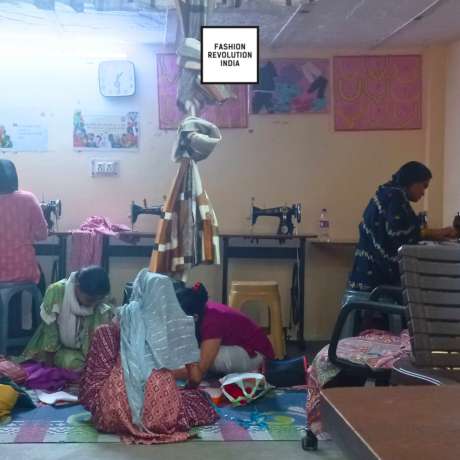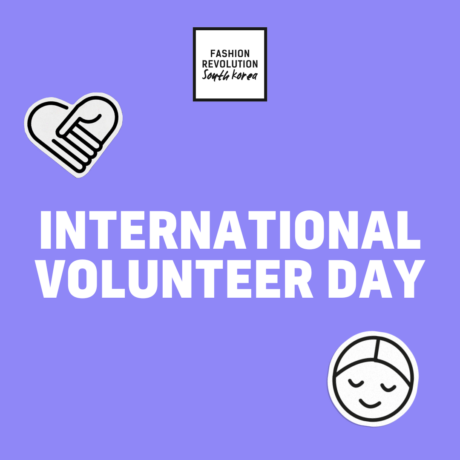From waste to wages: Experts explore transparency in the fashion supply chain
Earlier this month, we launched our seventh edition of the Fashion Transparency Index, a tool we use to incentivise the world’s largest fashion brands and retailers to disclose more infomation about their social and environmental policies, practices and impacts, in their operations and supply chain.
But we are not alone in calling for transparency. We are one voice of many civil society groups, including NGOs and trade unions representing supply chain workers and environmental advocates, that want to see more transparency in the fashion industry. That’s why we brought on a range of affected stakeholders and experts in the supply chain to explain why transparency matters to them. Here, you can explore some highlights from these viewpoints in the Fashion Transparency Index 2022.
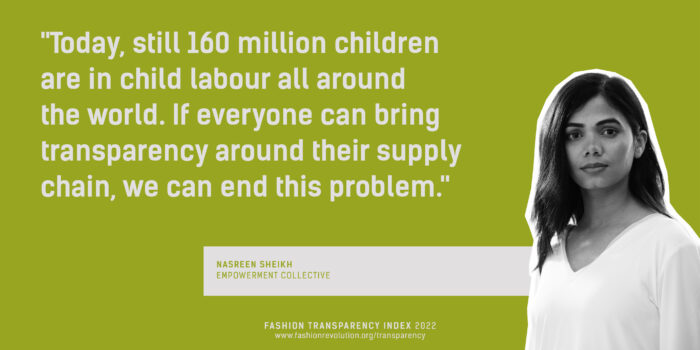
Supply chain traceability
More major brands than ever, 48%, now publish a list of their first-tier manufacturers, where the final stage of production occurs, e.g. cutting, sewing, finishing products and packing them for shipment. It is encouraging to see progress across different market segments including luxury, sportswear, footwear and accessories and across different geographies. In the early years of the Fashion Transparency Index, there was considerable resistance from brands to disclose their supplier lists, so it is positive that now, nearly half of the major brands in this Index publish such a list, covering at least a core selection of their manufacturing facilities.
“Brands around the world are preparing for a host of new ESG reporting requirements, with organisations from across the sector, in turn, preparing to provide, process, and work with that data. The volume of information will be enormous. It is therefore absolutely critical that reporting is built on a reliable and collaborative foundation in order to bring about the supply chain improvements we desperately need. That foundation cannot exist if data is siloed or inconsistent. Open, standardised, and transparent supply chain data is essential.”
Natalie Grillon
Executive Director, OPEN APPAREL REGISTRY
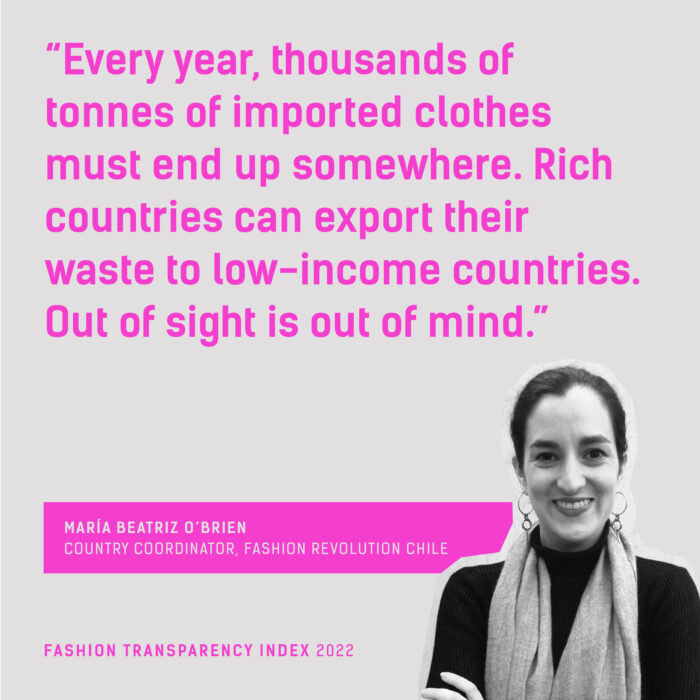
Governance
The Fashion Transparency Index 2022 found that a growing number of brands and retailers are disclosing information about how their board is accountable for sustainability impacts, yet there is little disclosure on employee incentives to improve companies’ human rights and environmental practices.
“The CEOs and executives are incentivised to improve or maintain high standards in relation to human rights and the environment, this is a clear indicator that these issues are built into the governance of the company, that they will be regularly discussed at the board level and company policies will be implemented. Yet only 24% of major brands and retailers disclose if CEO and executive pay is tied to human rights and environmental performance and even fewer (11%) disclose the percentage of executive pay linked to achieving these targets. Alongside evaluating the competencies of the board this will be a strong indicator that companies are equipped to manage these issues.”
Maria Van Der Heide, Head Of EU Policy, SHAREACTION
Martin Buttle, Head Of Good Work, SHAREACTION
Forced labour
Raw material suppliers are those that provide brands and their manufacturers with materials such as fibres (cotton, wool, viscose, polyester, nylon and more), hides, rubber, dyes, chemicals, metals and so on. The raw material level of the supply chain is where brands typically have the least visibility and hence where many human rights and environmental abuses often thrive, yet go unseen.S upply chain traceability is more important than ever considering the toll the pandemic has had on supply chain workers across the world and the global ongoing issues of forced labour, including the well-documented cases within the Chinese cotton and Tamil Nadu textile sectors.
“To meet the law’s goal of ending the importation of goods made with Uyghur forced labor, we expect U.S. Customs and Border Protection (CBP) to enforce not only against shipments directly from the region, but also, for example, from some of the largest garment producing countries like Bangladesh, Vietnam, and Indonesia – all major destinations for yarn and fabric containing Uyghur Region cotton. This will require CBP to seek far more disclosure from apparel brands about their sources of fabric, yarn, and cotton since, according to the Fashion Transparency Index 2022, just 12% of 250 of the world’s largest brands and retailers disclose their raw material suppliers.”
Jewher Ilham, Forced Labour Project Coordinator, WORKER RIGHTS CONSORTIUM
Spokesperson, COALITION TO END FORCED LABOUR IN THE UYGHUR REGION
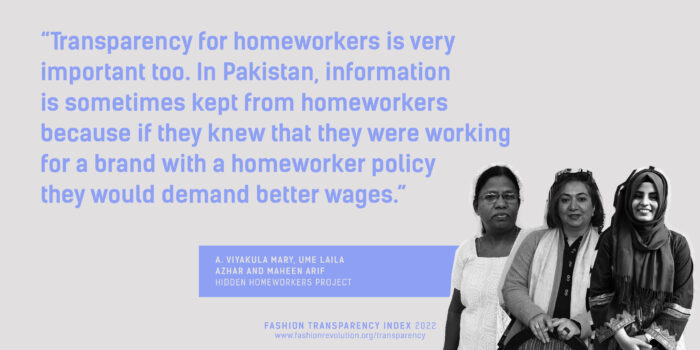
Homeworking
“This year’s Fashion Transparency Index shows that only 28% of brands have a homeworker policy. Many brands fear homeworking. They think that it’s something they cannot handle. This is a problem, as without a homeworker policy, suppliers will not disclose that they use homeworkers. If the brands do not know that homeworkers are involved, how can they conduct effective human rights due diligence (HRDD) processes within the supply chain? Even brands with homeworker policies are not prioritising the issue with their suppliers. Overall, it is clear that brands need to invest in sensitising their supply chain around homeworking.
Homeworkers need to be well managed like other workers in the supply chain. But where there is no recognition of homeworkers, there can be no proper system to manage them. Only 7% of brands have disclosed ways in which they are working to improve conditions for homeworkers. So work is coming to homebased workers but they are not being paid equally for it. They are exploited because of their invisibility. If brands do not have a nuanced understanding of homeworking, they should go via an NGO or homeworker organisation. But all brands need to have a policy that recognises homeworkers as workers.”
A. Viyakula Mary, Ume Laila Azhar, Maheen Arif
HIDDEN HOMEWORKERS PROJECT
Living wages
Our research reveals that there is less transparency the further down the supply chain we look. 48% of brands published the name of the factories where their clothes are made, but only 8% named the farms, where their raw materials like cotton come from.
“8% only is very, very shocking. And further that’s where the most of the modern day slavery injustices are happening. And the companies know their lowest stages of their supply chain are completely broken. Underserved communities are desperate. So we say to companies and leaders of these organisations – you need to see these workers and acknowledge them. Big fashion brands have the responsibility to see these workers and to acknowledge them, and help them to attain basic human rights. But it is really shocking that only 8% are transparent about where their raw materials are from. So is that how broken our system is?”
Nasreen Sheikh
Founder, EMPOWERMENT COLLECTIVE
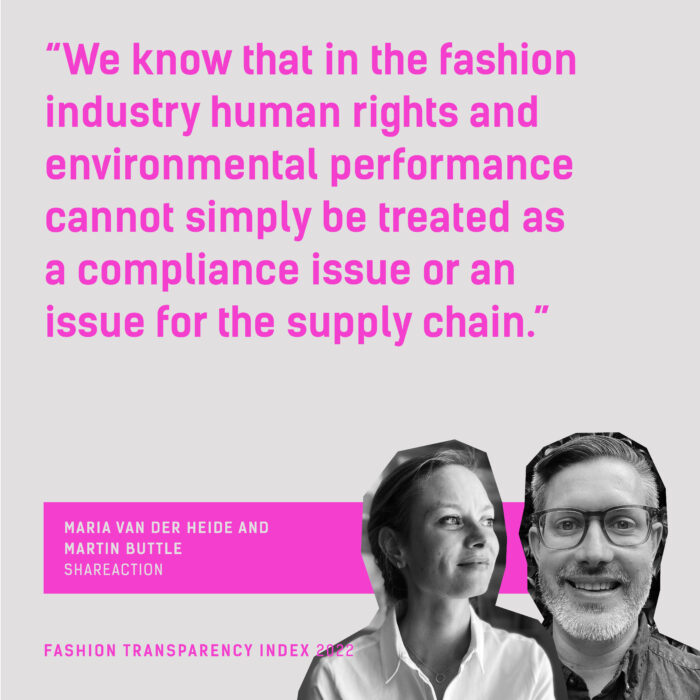
Purchasing practices
“If apparel retailers and brands do not practise transparent pricing and purchasing, an enabling environment for transparency across the supply chain cannot be created. In the global supply chain, transparency cannot be a stand-alone responsibility for the manufacturers and suppliers only. For ensuring transparency throughout the entire supply chain, a trusted and predictable relationship between all the stakeholders is key.
The garment industry cannot continue on a wing and prayer like this. We surely need to have some say in our own destiny; our survival cannot be in the lap of gods. This means getting a grip on the issue of purchasing practices once and for all. It means working together, collaboratively, as an industry to ensure we are singing from the same hymn sheet as regards pricing and contract negotiations.”
Mostafiz Uddin
Managing Director, DENIM EXPERT LTD
Founder, THE BANGLADESH DENIM EXPO
Collective bargaining
Major brands continue to source much of their garment production from countries where it is impossible, difficult and/or unsafe for workers to form trade unions and bargain for greater rights. However, in spite of the disconnect from their sourcing practices, most brands are avid in communicating their commitment towards upholding these enabling rights. The vast majority (84%) of brands publish a policy outlining their commitment to freedom of association, the right to organise and collective bargaining at supply chain level.
“The 2022 FTI shows that 209 brands out of 250, or 84%, published policies on freedom of association, right to organise and collective bargaining, but only 13% of brands disclosed which suppliers had worker-led unions at the factories, while only 10% disclosed the percentage of workers in their supply chain covered by collective bargaining agreements, among them only 1% were provided wages higher than the legal minimum. This shocking picture well illustrates the reality; brands and suppliers continue to pay lip service instead of practicing collective bargaining as the ultimate solution to fix workplace issues at the root.”
Han Dongfang
Executive Director, China Labour Bulletin
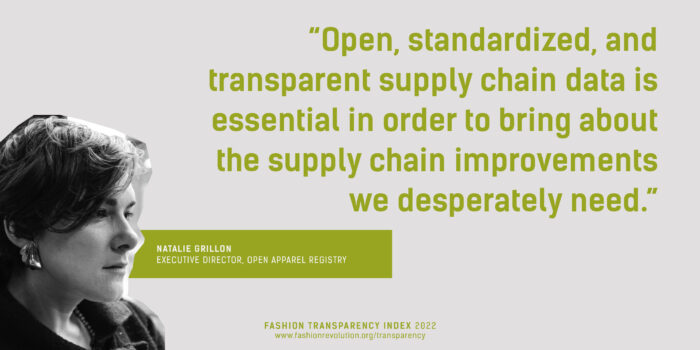
Diversity and inclusion
Major fashion brands are increasingly visible in their public support of racial equality, including positioning themselves in solidarity with movements like Black Lives Matter and Stop Asian Hate on social media. Yet, we have found that only 3% of brands voluntarily disclose the annual ethnicity pay gap in their own operations, and just 8% publish their actions on racial and ethnic equality in their supply chains. This is particularly striking given that huge volumes of production occur in regions where migrant, caste and ethnicity issues facilitate labour abuse and exploitation.
“Currently only 3% of companies publish annual ethnicity pay gaps, including by distribution of job roles (e.g. executive level, managers/supervisors, employees) within the company (head office, retail stories, owned and operated facilities). Transparency of this data is critical in order to understand the power dynamics that create the conditions of have and have nots in the fashion industry, which has operated under a colonial capacity of white, male CEOs who are among the world’s richest individuals, to BIWOC garment workers that are largely left destitute. In other words, diversity is not just a cosmetic tool to be politically correct. We need to expand the modalities in which diversity can exist, so as to not limit it to a marketing tactic, but a channel to unlock systemic equality.”
Aditi Mayer
Sustainable Fashion Content Creator, Photojournalist, Labour Rights Activist, Environmental Justice Speaker
Textile waste
For too long, the fashion industry has hidden and ignored the truth of overproduction and overconsumption. Rather than taking responsibility for downstream impacts, they have disclosed more information about the circular solutions they are developing (28%) than on the actual volumes of pre- (10%) and post-production waste (8%) they produce. Brands have sat by as waste-importing countries foot the bill, resulting in serious human rights and environmental implications.
“The Atacama Desert is the second largest textile landfill in the world. Most bales come in unsorted and the regional government has banned throwing textiles in the local trash. Every year, thousands of tonnes of imported clothes must end up somewhere. Out of sight is out of mind. Rich countries can export their waste to low-income countries; wealthy neighbourhoods can do the same inside their own territories. Around 50 landfills are dispersed throughout the area, with little chance of clothing recovery. According to the Fashion Transparency Index 2022, only 15% (38/250 brands) of brands surveyed disclose the quantity of products produced during the annual reporting period. In 2021, the data corresponds to 14% (34/250 brands). Very little progress has been made. Without knowing how much is produced, it’s hard to control and hold brands accountable for the items dumped in landfills worldwide.”
María Beatriz O’Brien
Country Coordinator, FASHION REVOLUTION CHILÉ
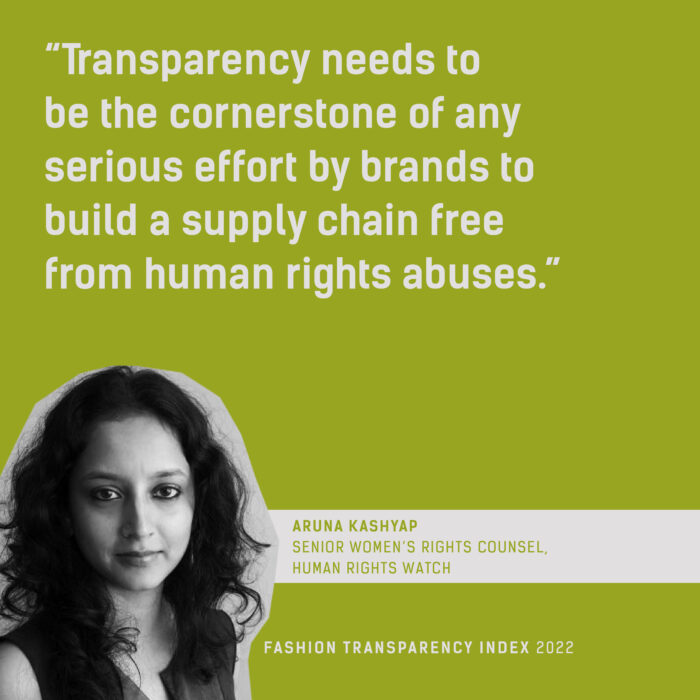
Greenwashing
“A key area of regulation being pursued by policy-makers in the UK and the EU, is clamping down on rampant greenwashing which misleads consumers and acts as a smokescreen for unsustainable practices to proliferate. Action has been taken on companies from Everlane to adidas for making unsupported claims.
Recently, Norway’s Consumer Protection Authority ruled that the use of the Higg Index Sustainability Profiles to substantiate green claims, as Norwegian brand Norrøna was doing, will be henceforth illegal. This has big implications for the use of such certification for brands in the EU, as it is likely to also be breaking the law in other member states. At Changing Markets we have been highly critical of the SAC and The Higg Index.
The latest rulings are just the tip of the iceberg for cracking down on weak certification and it is clear that stamping out greenwashing in all its forms must be a two pronged approach; disincentivise making false claims and establish a benchmark for sustainable practices. As the slow train of regulation chugs into motion, it will still be several painstaking years before sustainable practices are more than toothless rhetoric.”
George Harding-Rolls
Campaign Manager, CHANGING MARKETS FOUNDATION
Circularity
The overwhelming link between human dignity and the climate emergency means there has never been a greater need for an accelerated and systemic shift toward a circular economy which promises to enable a restorative and regenerative industry. A shift would mean taking the existing opaque, complex and fragmented global fashion value chain and expanding it to include new activities and segments to account for new sources of raw materials from waste streams that will need to be collected, sorted and recycled into textile inputs. It would require brands to be responsible for their downstream supply chains, i.e. recovery of post-consumer textiles and support for partners involved in recovery and waste management; it is a complex and multi-layered process.
“Employers and governments have a responsibility to think strategically about how the worsening climate crisis impacts workers everywhere and how to update their policies in response. We are a globalised and interconnected society. Any approach taken on the climate crisis must have a global lens and consider impacts for all stakeholders, workers especially, and not just focus on individual country’s obligations to limit waste and protect environments. Labour policies are too often an afterthought in circularity plans. Upskilling and reskilling are powerful tools to ensure adaptable workforces.”
Sarah Krasley, Founder & CEO, SHIMMY TECHNOLOGIES
Ashley Nichols, Special Projects Manager, SHIMMY TECHNOLOGIES
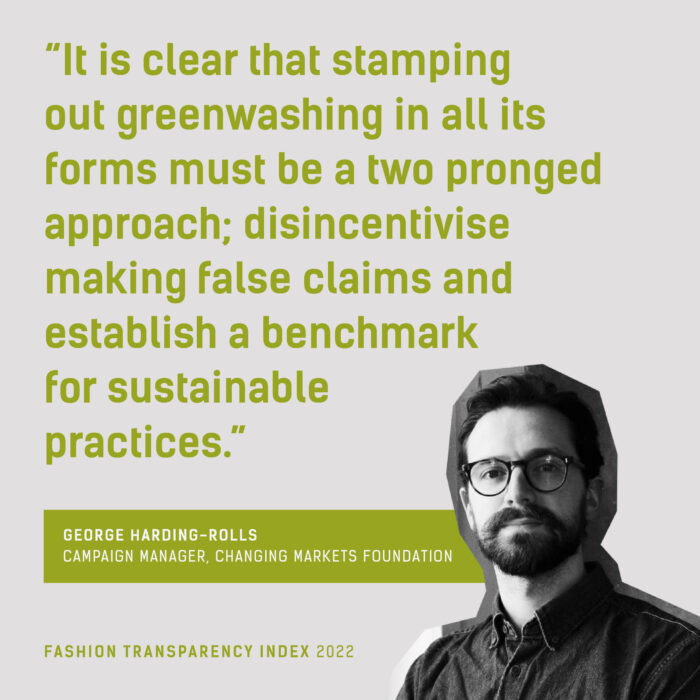
Hazardous chemicals
“The fact that more brands report their use of Manufacturing Restricted Substances Lists (MRSLs) and Restricted Substances List (RSLs) in the 2022 Fashion Revolution Transparency Index shows progress and that on the whole, the momentum begun by the Greenpeace campaign is not only being maintained but is slowly spreading. Industry stakeholders such as ZDHC, which provides tools and support for companies to implement Detox, have played a major role so far, and maintain an ongoing programme for the elimination of hazardous chemicals open to the entire textile sector. Nevertheless, there is a concerning decline in the publication of wastewater test results from suppliers – the cornerstone of a company’s Detox Commitment which reveals progress on hazardous chemicals as well as giving local people and civil society the right to know about water pollution.
“Commitments to reduce fossil fuel based synthetic fibres and reporting on progress need to be on a much bigger scale; about 70% of the throwaway clothes made by fast fashion brands are mostly plastic, which depend on toxic extraction and create an impossible waste problem. These plastic clothes release millions of microplastic fibres into our rivers and oceans with every wash. But the fact that even brand new clothes that can’t be sold are piling up as waste reveals the sickness at the heart of the linear business models of fashion.“
Viola Wohlgemuth
Consumption And Toxics Campaigner, GREENPEACE GERMANY
Carbon emissions
As we get closer to a major milestone on the journey to net zero, the year 2030, accurate reporting, target-setting in line with science, and transparency on implementation plans around carbon are becoming increasingly important for the apparel sector.
“Crucial to progressing on this journey to net zero is accurate accounting for scope 1 & 2, and most importantly scope 3 emissions. Scope 1 & 2 refer to emissions relating to a company’s own emissions within its direct control i.e. stores, offices and warehouses. While these emissions are within direct control, they typically represent less than 10% of a company’s overall impact, as scope 3 emissions, those in the value chain, account for the majority of the environmental impact a brand has. Scope 3 is split into a variety of categories, the most important of which is category 1a, purchased goods and services – all of the upstream emissions associated with the production of garments from raw material to product assembly. If a company is not reporting on all scope 3 emissions, it is not communicating its true impact. From this year’s analysis we see only a third of the biggest brands are doing so. This suggests that many brands are either not aware of their full carbon impact or are not being transparent about it. A lack of awareness and transparency here prevents companies from clearly communicating their reduction efforts.”
Pauline Op De Beeck
EU Business Development Manager & Sustainable Fashion Lead, THE CARBON TRUST
Read the Fashion Transparency Index





